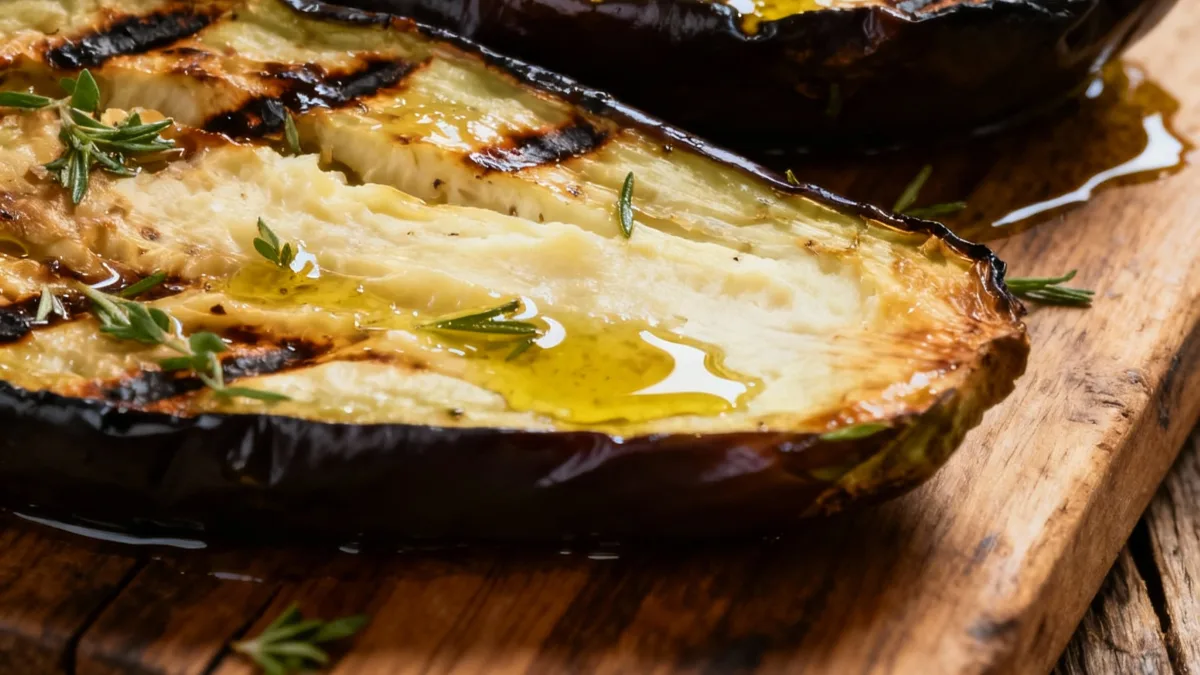Okay, so, let’s talk eggplant. Specifically, Roasted Eggplant Halves. If you’ve ever stared into your crisper drawer, wondering what on earth to do with that big ol’ purple beauty, I’ve got your back. Forget those sad, mushy, flavorless eggplant dishes you might have endured in the past. We’re talking about something seriously delicious, ridiculously easy, and versatile enough to be your new go-to meal.
Seriously, have you ever tried roasting eggplant and been utterly disappointed? I’ve been there. It felt like a culinary crime scene sometimes. But then I discovered the magic of roasting it halved, and let me tell you, life changed. It’s simple, it’s elegant, and the flavor? Chef’s kiss.
Why Halves Are the Way to Go
You might be thinking, “Halves? What’s the big deal?” Well, let me break it down for you. Roasting eggplant in rounds or cubes can sometimes lead to uneven cooking. One piece is perfectly tender, and the other’s still got that tough bite. Not ideal, right?
When you roast eggplant halves, you’re giving it a chance to really cook through beautifully. The flesh gets wonderfully soft and creamy, almost like a rich purée, while the skin crisps up just enough. It’s the best of both worlds, honestly.
Here’s why I’m obsessed with this method:
- Even Cooking: The thick flesh cooks through without drying out.
- Flavor Infusion: The cut surface acts like a little bowl, perfect for soaking up all those delicious seasonings.
- Presentation: They look gorgeous! Fancy enough for guests, but easy enough for a Tuesday night.
- Less Oil Needed: Because you’re not constantly flipping small pieces, they don’t absorb as much oil. Score!
The Magic Ingredients: What You’ll Need
Honestly, this is where the beauty of roasted eggplant halves truly shines. You don’t need a mile-long ingredient list. It’s all about letting the eggplant be the star, with just a few supporting actors.
Here’s the basic cast:
- Eggplant: Obviously! Choose medium-sized ones that feel heavy for their size.
- Olive Oil: Good quality extra virgin olive oil is your friend here. Don’t skimp!
- Salt: Kosher salt or sea salt works wonders.
- Black Pepper: Freshly ground, always.
- Garlic: Fresh minced garlic or garlic powder – your call.
That’s it. That’s the core. But of course, we can get fancy.
Leveling Up Your Eggplant Game
Want to go from “good” to “OMG, what is this?” Here are some ideas to jazz it up:
- Herbs: Fresh rosemary, thyme, or oregano are divine.
- Spices: A pinch of smoked paprika, red pepper flakes for a kick, or even some cumin.
- Acids: A squeeze of lemon juice or a drizzle of balsamic glaze after roasting.
- Toppings: Toasted nuts, crumbled feta or goat cheese, a dollop of tahini, or fresh parsley.
FYI, the possibilities are pretty much endless. Don’t be afraid to experiment!
Roasting 101: Let’s Get This Party Started
This is the easiest part, I promise. It’s almost laughably simple. You’ll wonder why you didn’t do it sooner.
Step-by-Step to Deliciousness
- Preheat Your Oven: Crank that oven up to 400°F (200°C). This high heat is key for getting that nice char and tender interior.
- Prep the Eggplant: Wash your eggplants. Slice them in half lengthwise. Don’t peel them – that skin is edible and delicious when roasted!
- Score and Season: Take a sharp knife and score the cut side of the eggplant halves in a diamond pattern. Don’t cut all the way through to the skin. This helps the heat penetrate and allows the oil and seasonings to get right into the flesh.
- Oil It Up: Brush or drizzle a generous amount of olive oil all over the scored flesh. Make sure it gets into those cuts.
- Season Generously: Sprinkle liberally with salt and pepper. If you’re using minced garlic or dried herbs, sprinkle those on now too. Don’t be shy; eggplant is a sponge!
- Roast Away: Place the eggplant halves cut-side up on a baking sheet. Roast for 30-45 minutes, or until the flesh is super tender and can be easily pierced with a fork. The exact time will depend on the size of your eggplant. You want it soft, not firm.
- Optional Broil: For an extra crispy, slightly charred top, you can pop them under the broiler for 1-2 minutes at the very end. Watch them like a hawk though – they can go from golden to burnt in seconds!
See? I told you it was easy. No complex techniques, no fancy equipment. Just pure, simple goodness.
Serving Suggestions: What to Do With Your Masterpieces
Now that you’ve got these glorious roasted eggplant halves, what do you do? This is where the fun really begins.
Mealtime Versatility
- As a Side Dish: Serve them alongside grilled chicken, fish, or steak. They’re a fantastic, healthy alternative to potatoes.
- As a Main Course: Stuff them! Top with cooked grains like quinoa or rice, some sautéed veggies, beans, and a drizzle of tahini or a marinara sauce. Add some cheese if you’re feeling indulgent. Suddenly, you have a hearty vegetarian meal.
- In Salads: Scoop out the tender flesh and toss it into a warm grain salad or a Mediterranean-style salad.
- As a Dip Base: Mash the flesh with some tahini, lemon juice, garlic, and a pinch of salt for a quick and smoky baba ghanoush-style dip.
IMO, the “stuffing” route is probably my favorite. It feels so satisfying and you can customize it to whatever you have in your pantry. It’s a meal that looks impressive but requires minimal effort. What’s not to love about that?
Troubleshooting Common Eggplant Woes
Even with this simple method, sometimes things don’t go exactly as planned. Let’s address a couple of common hiccups.
Will it be Bitter?
Some eggplants can have a bitter taste, especially older ones. Salting the eggplant before roasting can help draw out some of those bitter compounds. You can do this by slicing the eggplant, salting the cut surfaces generously, letting it sit for about 30 minutes, then rinsing and patting it dry before proceeding with the oil and seasonings. However, with the halved method and good seasoning, I rarely find bitterness to be an issue anymore.
Is it Cooked Enough?
The key is tenderness. If your eggplant is still firm after 45 minutes, it just needs more time. Every oven is different, and eggplant sizes vary. Just keep it in there until a fork glides through it like butter. If the skin starts to look too black and brittle, you can loosely tent it with foil to prevent burning while the inside finishes cooking.
The Final Verdict: Embrace the Halves!
So there you have it. Roasted eggplant halves aren’t just a recipe; they’re a revelation. They’re proof that simple ingredients, treated with a little heat and love, can create something truly spectacular. They’re proof that you don’t need to be a gourmet chef to make a delicious, impressive meal.
Next time you see an eggplant, don’t pass it by. Grab a couple, slice ‘em in half, and get roasting. You’ll thank me later. Trust me on this one. Happy roasting!

Caramelized Roasted Eggplant Halves
Ingredients
Method
- Preheat oven to 425°F (220°C). Line a large baking sheet with parchment paper.
- Slice the eggplants in half lengthwise. Using a sharp knife, score the flesh in a crosshatch pattern about ½ inch deep, being careful not to pierce the skin.
- Brush the cut sides generously with olive oil, making sure it seeps into the cuts. Season with salt, pepper, and smoked paprika if using.
- Arrange the eggplant halves cut-side down on the prepared baking sheet.
- Roast for 35–45 minutes, until the flesh is very tender and the edges are caramelized and golden brown.
- Remove from the oven and carefully flip the halves cut-side up. Drizzle with balsamic vinegar or pomegranate molasses for a touch of sweetness and shine.
- Sprinkle with chopped herbs before serving. Serve warm as a side dish or top with yogurt, tahini, or feta for a light meal.

